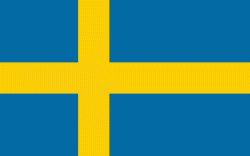Upplands Väsby (Upplands Väsby)
Upplands Väsby is a locality and the seat of Upplands Väsby Municipality, Stockholm County, Sweden with 48,907 inhabitants in 2020.
The municipality has a long history with clear traces of settlements from the pre-Christian times in several places. The first traces of human culture have been found during excavations of Hammarby ridge, about 400 meters south of the current Glädjen junction, where the excavation of the burial ground Ekebo found a bronze axe from around 600 to 700 BC. Upplands Väsby has a low topography and the people lived by fishing, seal and waterfowl hunting. Several finds of foreign coins testify to the extensive trade with foreign countries. They include Arabic coins found at Great Wäsby castle grounds.
At Runsa and Skavsta's prehistoric fortifications, known as hill forts. Traces of aboriginal burial grounds are found in many places in the form of mounds, stone circles, standing stones, or minor bumps. The graves are sometimes the shape of a ship, as at Runsa, one of Sweden's most famous stone circles. It is 56 meters from the bow and stern and was made in 400-500 AD. Other cemeteries in the form of large burial mounds exist near Löwenströmska Hospital and Runby, called Zamores Hill after the timpanist Antonin Zamore, a North African who came to Sweden in the late 1700s and who lived on the Runby Lower farm, now called the homestead. The largest cemetery is the Great Wäsby Castle ättebacke with around 200 burial mounds.
In the early 1900s, Upplands Väsby was a small station community. The railway between Stockholm and Uppsala, built 1863–1866; the station house in Väsby was completed in 1865. Around the station, a society grew. Anton Tamm had bought up all the land that the present society is built on. In 1903 Tamm, at the time was CEO of Optimus, established the first major industry, Väsby Werkstäder. The company manufactured brass and copper, including Optimus products. Väsby Werkstäder was bought in 1917 by Finspongs Metallverk AB. Over the years, the company changed its name many times, but was popularly always called Messingen. They were later Swedish Metal Works and Granges-Weda and offered die casting and plastic manufacturing.
The municipality has a long history with clear traces of settlements from the pre-Christian times in several places. The first traces of human culture have been found during excavations of Hammarby ridge, about 400 meters south of the current Glädjen junction, where the excavation of the burial ground Ekebo found a bronze axe from around 600 to 700 BC. Upplands Väsby has a low topography and the people lived by fishing, seal and waterfowl hunting. Several finds of foreign coins testify to the extensive trade with foreign countries. They include Arabic coins found at Great Wäsby castle grounds.
At Runsa and Skavsta's prehistoric fortifications, known as hill forts. Traces of aboriginal burial grounds are found in many places in the form of mounds, stone circles, standing stones, or minor bumps. The graves are sometimes the shape of a ship, as at Runsa, one of Sweden's most famous stone circles. It is 56 meters from the bow and stern and was made in 400-500 AD. Other cemeteries in the form of large burial mounds exist near Löwenströmska Hospital and Runby, called Zamores Hill after the timpanist Antonin Zamore, a North African who came to Sweden in the late 1700s and who lived on the Runby Lower farm, now called the homestead. The largest cemetery is the Great Wäsby Castle ättebacke with around 200 burial mounds.
In the early 1900s, Upplands Väsby was a small station community. The railway between Stockholm and Uppsala, built 1863–1866; the station house in Väsby was completed in 1865. Around the station, a society grew. Anton Tamm had bought up all the land that the present society is built on. In 1903 Tamm, at the time was CEO of Optimus, established the first major industry, Väsby Werkstäder. The company manufactured brass and copper, including Optimus products. Väsby Werkstäder was bought in 1917 by Finspongs Metallverk AB. Over the years, the company changed its name many times, but was popularly always called Messingen. They were later Swedish Metal Works and Granges-Weda and offered die casting and plastic manufacturing.
Map - Upplands Väsby (Upplands Väsby)
Map
Country - Sweden
 |
 |
| Flag of Sweden | |
Nature in Sweden is dominated by forests and many lakes, including some of the largest in Europe. Many long rivers run from the Scandes range through the landscape, primarily emptying into the northern tributaries of the Baltic Sea. It has an extensive coastline and most of the population lives near a major body of water. With the country ranging from 55°N to 69°N, the climate of Sweden is diverse due to the length of the country. The usual conditions are mild for the latitudes with a maritime south, continental centre and subarctic north. Snow cover is infrequent in the densely populated south, but reliable in higher latitudes. Furthermore, the rain shadow of the Scandes results in quite dry winters and sunny summers in much of the country.
Currency / Language
| ISO | Currency | Symbol | Significant figures |
|---|---|---|---|
| SEK | Swedish krona | kr | 2 |
| ISO | Language |
|---|---|
| FI | Finnish language |
| SE | Northern Sami |
| SV | Swedish language |















